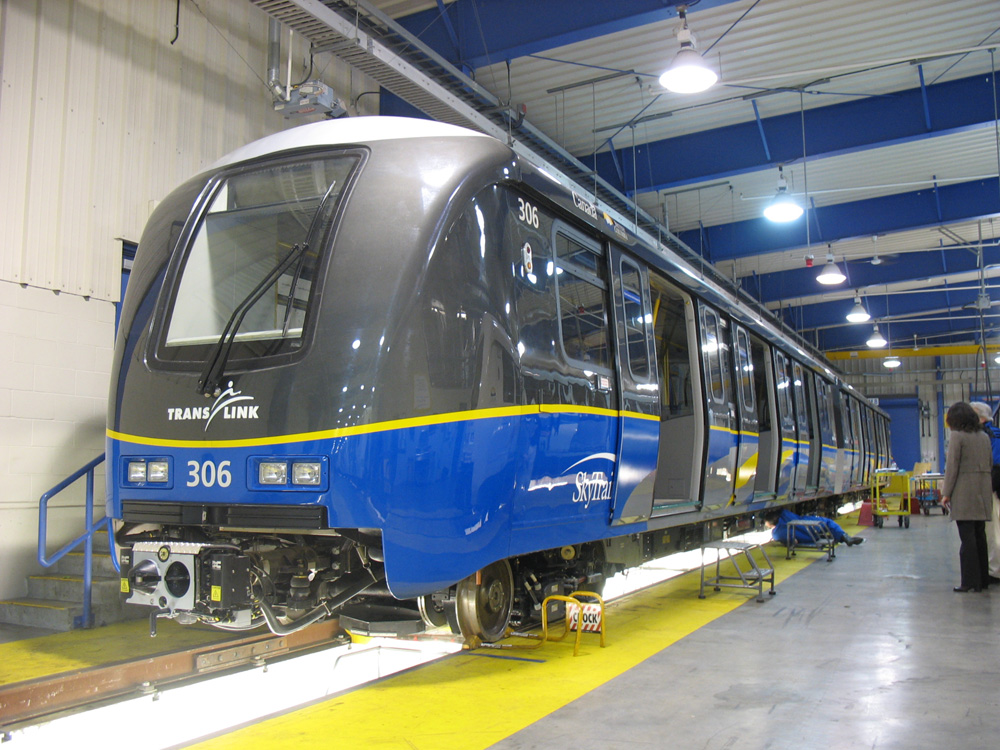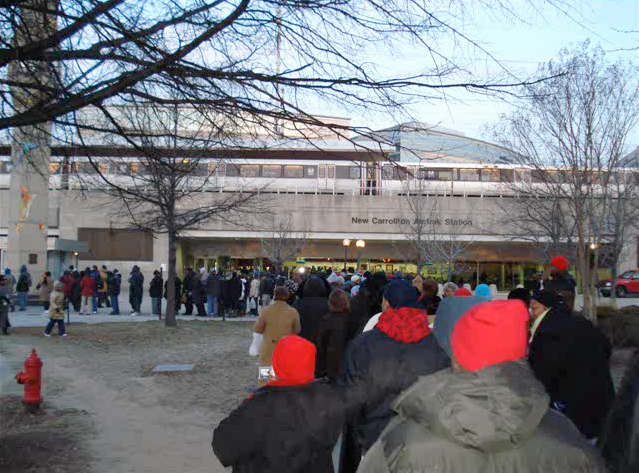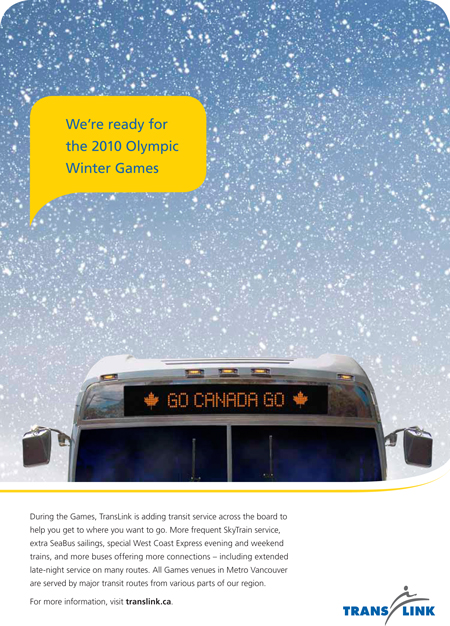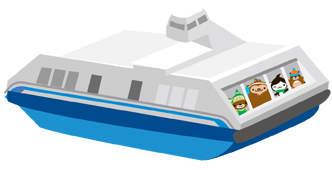TransLink’s Olympic story, part 1: how we’re getting ready for the Games
TransLink’s Olympic story, part 1: how we’re getting ready for the Games
As you certainly know, the Olympics arrive in February, and TransLink has the enormous task of helping people travel during the Games. So I’ve put together a series of articles illustrating the scope of this challenge and just how TransLink is preparing to handle it. Here’s the first article, giving an overview of our work on the transportation strategy.
When the 2010 Winter Olympics brings thousands of visitors to Vancouver in February, our transportation system will face its biggest challenge in history.
“It’s like having three Superbowls a day for 17 days,” said Mike Madill, vice-president of Olympic Transportation at TransLink. “We’re planning for rush hour traffic conditions all day.”
It’s a traffic challenge every Olympic host city must handle. Thousands of Olympic visitors must be moved, on time, to scheduled events and celebrations… while still serving the travel needs of local residents.
But just like many host cities, Vancouver has been working on this challenge since the bid. And for TransLink, the transit services we provide play a key role in Games transportation.
At the heart of our plans are Mike and the TransLink Olympic transportation team. For over two years now, the 11-member team has minutely focused on those 17 days of Olympic events, planning our strategy to serve our customers as best as possible, despite the enormous demand of the Games.
TransLink’s role in the Games
It’s important to note that TransLink isn’t responsible for every bit of transportation during the Games. In September 2008, Mike, SkyTrain CEO Doug Kelsey, and the Olympic Transportation team finalized an agreement with the Vancouver Olympic Organizing Committee (VANOC), defining our Games funding, and responsibility in the following areas:
- Providing public transit in Metro Vancouver for spectators and the Olympic workforce, taking them to “city venues” and celebrations, while continuing to provide service for existing transit customers;
- Leading regional initiatives to encourage travel alternatives to single-occupancy vehicles; and
- Co-leading the Transportation Management Centre (TMC) with VANOC. The TMC connects the operation centres of the regional transportation partners to help ensure smooth travel during the Games.
- Transit queue management outside transit stations (a later addition to the agreement).
Again, bear in mind that our focus is solely on Metro Vancouver. VANOC is actually responsible for transportation to Whistler and Cypress, as well as all athlete, officials, VIP, media and sponsor transport. And B.C. Transit is taking care of travel within Whistler.
Making the plan come alive

Since defining our role with VANOC, Mike and the Olympic transportation team have been fleshing out just how to deliver on our responsibilities for the Games.
The transportation team has also been working with our subsidiaries to provide extended hours of service, and to make sure our transit services can carry the high numbers of passengers expected. About 30 per cent more people are expected to ride the system every day: a jump from 700,000 daily passengers to over 1 million.
“It’s uncharted territory for us,” says Mike. “But we’ve had other events like Celebration of Light, where there can be hundreds of thousands of passengers on a big night. We’re able to rely on our expertise and say, we know how to do that, so we should be able to handle Games events as well.”
So, orders of new vehicles made years ago are now arriving in time to increase capacity on the system for the Games period, including 48 new SkyTrain cars on the Expo and Millennium Lines. Many older buses are also being held back from retirement to handle the increased loads.
There’s also detailed planning work involved — like predicting the ebbs and flows of passenger volumes, figuring out where to store extra buses, locking in the exact locations of shuttle drop-off points at the venues, and coordinating our routes with Olympic road closures. Much has also been done to build the Transportation Management Centre at VANOC, where all regional transportation agencies will have representation during the Games.
Another big project has been trying to reduce car travel by locals in downtown Vancouver, since Olympic visitors will boost traffic in the already-bustling area.
So over the past year, our Olympic team has contacted more than 700 downtown businesses about the traffic challenge, and many have pledged to use alternatives to driving alone for the Olympic period. (UBC and SFU will also be closed for reading break during the Olympics, taking some more pressure off the system.)
And on top of our official roles, TransLink has put together a host program for the Olympics. About 200 staff from TransLink and its subsidiaries will be out at major transit hubs during peak volumes, to make sure people know how to get where they’re going and answer any questions about public transit.
Research: the Beijing Olympics and the Obama inauguration

The TransLink Olympic team hasn’t been planning their strategy in isolation, though.
Advice has come from veterans of the 2002 Salt Lake City Winter Olympics, who now work with the Vancouver Olympic transportation team.
Individual staff members also undertook research trips to the 2008 Beijing Olympics and the 2009 inauguration of President Obama in Washington, D.C.
There were useful lessons from both events. In Washington, Mike went behind-the-scenes with the local transit agency and got to see their operations centre in action. It was also startling to see how early lineups formed for the event: riders started lining up at 4 a.m., even though the inauguration was held at 11 a.m, and the ride was only 30 minutes.
But the agency’s transit host program was very effective, and staff kept the lineups well informed about what to expect. And there was an unexpected lesson: far fewer people were needed to manage the line than he would have guessed.
“The key thing is to have someone going up and down line, giving out info on how big the lineup is, and informing them if they are in the right line, which is the biggest stressor for people,” he explained.
In Beijing, a few pieces of signage were confusing or poorly placed. But Mike saw that loading riders onto the transit system after events was managed as expected – through the use of barricades, signage, and helpful staff.
“What they had there that we won’t have here though is just a whole ton of people,” he said. “I think they got every kid in university and brought them in, and they were the volunteers.”
“I’d say DC is probably more applicable, even though it was only the one targeted event,” he said. “I think that those are the kind of lineups we’re going to see. Beijing was bit more artificial in a way, because of the way the country is governed. They had a lot of levers to manage things that we just don’t have.”
The Games are approaching: “I’m feeling good about where we are”

After two years of work on the biggest event our public transit system will ever handle, Mike’s still quite cheerful about the whole experience.
“It is kind of a surreal thing to do,” he explained. “It’s a fair bit of pressure but it’s got moments that make it feel that it’s worthwhile.”
“The Olympic Games, for us in transportation, is all about doing the best that we can do in delivering our service. It’s the biggest challenge that we’ll ever get for public transit in the city. It’s our time to shine, and it’s a great opportunity and a great challenge and I’m sure it’s going to be a very rewarding experience for everybody.
And with the Olympics coming up fast now, the two years of hard work seem to be paying off. Mike and the team have just a few bits of fine-tuning to be done—and not too much more.
“I’m feeling good about where we are,” said Mike. “I think we’re where we should be.”
Stay tuned for more TransLink Olympic articles, including one on the Transportation Management Centre, our host program, our bus strategy, and more.







Seeing the headsign in the Olympic readiness ad reminds me to mention the following.
A few weeks ago, I saw a bus with a headsign reading “WELCOME 2 CANADA”. To me and the few people I’ve mentioned it to, that comes off at best as something written by a teenager on a mobile phone, or worse, as “wee kant rite propur inglish”; either way, not something I would want to greet visitors to our country with.
I’m not so riled up by the “COUNTDOWN 2 GOLD” headsigns, as that sounds more like a marketing tagline where there can be some leeway for style. But “Welcome to Canada” is a regular phrase and as such should be written with proper English.
I hope you can pass this on to the right people to get it changed before the Olympics. Thanks!
While I frequently complain about changes to our language and the mistakes I see daily in print, I think Welcome 2 Canada is valid given the limited amount of space available on bus signs.
The alternative would be to have the message scroll. People would then be treated to “Welcome to Canad” or “elcome to Canada”
I prefer what CMBC chose.
I noticed this yesterday, and I noticed that “COUNTDOWN” and “2 GOLD” were displayed separately. I agree it looks very amateurish as well. You only save 1 character (“2” vs. “to”), doesn’t look good to visitors, and I think looks even worse to those from non-English speaking countries. Furthermore, it’s very annoying having to wait for the message to go through before being able to confirm the bus number it is operating as.
Hey Jhenifer,
Speaking of the Olympics! A few weeks ago you posted a link to opennings for help during the Olympics regarding Translink. My question is do you know if they still need help and who I should contact if so. I was originally trying to get a position with VANOC but they are full of volunteers and I still really want to help out during the games and if you know if they still need help I would love to be hooked up to help out. Let me know!
With regards to the signs. I can’t stand scrolling signs. Watching the CLine signage scroll to see the next station or which destination is so painful. I realize seniors don’t like small print. But being able to get that information with one glance is preferred.
With regards to Vanoc volunteers. I just got a position a few weeks ago when they saying they needed loaders, whistler workforce and Club 99 mobile forces.
Jim: Well, West Coast Express says you can still go to their website and fill out the form until January 15. No guarantees on a spot though. Here’s the link.
I whole-heartedly agree with the remarks disparaging “Welcome 2 Canada” and “Countdown 2 Gold”, and I think I mentioned so a few months ago when I saw the latter first appear. I was immediately embarrassed for TransLink and the city of Vancouver, as I am now. I sincerely hope this can be changed.
Unless promoting illiteracy is on the Olympic agenda, I can fathom no justification for such deliberate errors.
b
1 goal W Translink S hw canit reach ot 2 nu yungA demographics. UzN a Hybr of Textese n en cn B an option 2 reach ot 2 d Millennials or “Generation WE”.
http ://www.youtube.com/watch?v=vknHKTy1MLY
UzN Textese we cn save paint, NRG, n signage space. Translink S alrdy doiN dis on their buses W CHK syns. praps Jhenifer shd do a transl8N contest W her weekly poll.
Isn’t dis Kewl?
hw bout…. Go [|*|]!
Thanks Jhenifer!
Well, I’ve passed it on to CMBC but to be honest I don’t think there’s a whole lot that can be done at this point (the signs take some work to reprogram — it’s not as easy as flipping a switch). But be assured that your dissatisfaction with the spelling and messaging has been duly registered with the correct people :)
Thanks, Jhenifer, and sorry for the threadjack.
Back on topic, nice to know all the prep work that’s gone into keeping things moving during the games. I hope it pays off!
WE: Are you texting or something?
[…] The Olympics arrive in February, and TransLink has the enormous task of helping people travel during the Games. So here’s a series of articles illustrating the scope of this challenge and just how we’re preparing to handle it. This article focuses on the Transportation Management Centre, which connects all the regional transportation partners during the Games. (Check out the past article on TransLink’s overall Olympic strategy). […]
[…] program, helping people find their way on transit during the Games. (Check out past articles on TransLink’s overall Olympic strategy, and the Transportation Management Centre). TransLink transit hosts will be helping customers […]
[…] Anyway, we’ll be boosting service for the Games in February, so hopefully we’ll be able to handle all of it! And if you haven’t read it, here’s the overview article on how we have prepared for the Games. […]
It’s great to hear about all of the work and progress that’s being accomplished in preparation for the Olympics!
Regarding the spelling, although scrolling can be somewhat annoying, a “2” replacing “to” seems somewhat cheesy and it reminds me of cheap tourist T-shirts. In my opinion, scrolling on the signs would be less of an annoyance than “Welcome 2 Canada” ~
[…] traffic in key areas for the Olympics. (Check out past articles on Check out past articles on TransLink’s overall Olympic strategy, the Transportation Management Centre and the transit host […]
Thank you for the sensible critique. Me and my neighbor
were just preparing to do some research on this. We
got a grab a book from our local library but I think
I learned more from this post. I’m very glad to see such great info being shared freely out there.
Howdy! This post couldn’t be written any better!
Reading through this post reminds me of
my previous roommate! He constantly kept preaching about this.
I most certainly will send this article to him.
Pretty sure he will have a great read. I appreciate you for sharing!
I have read so many articles or reviews concerning the blogger lovers except this post
is actually a nice piece of writing, keep it up.